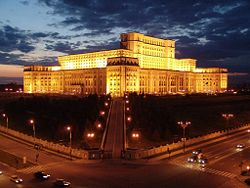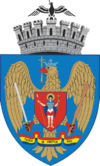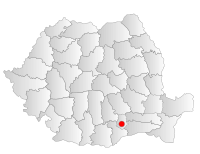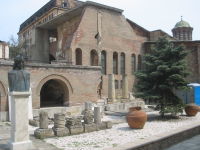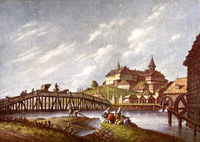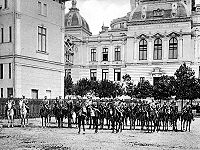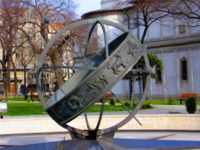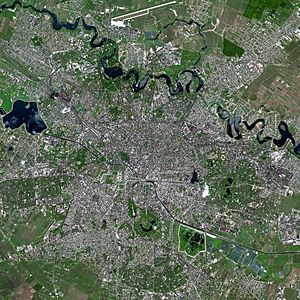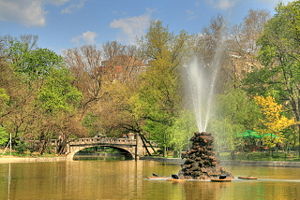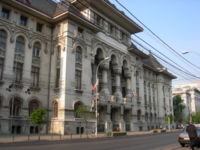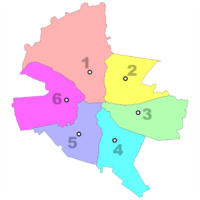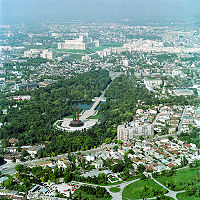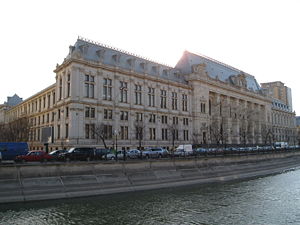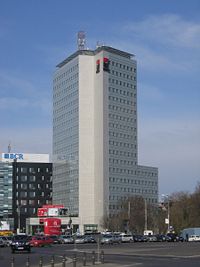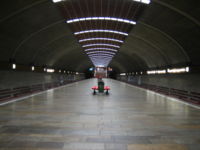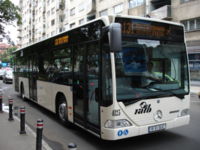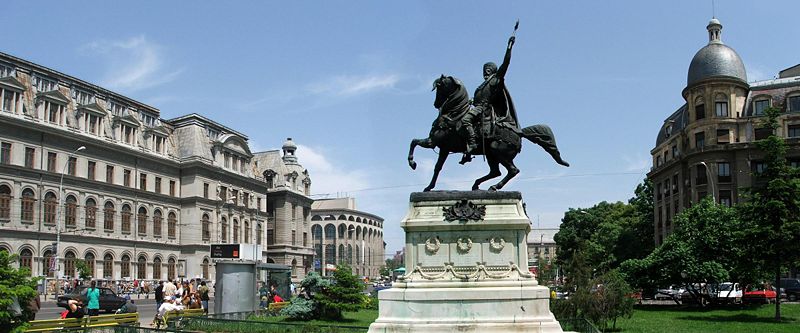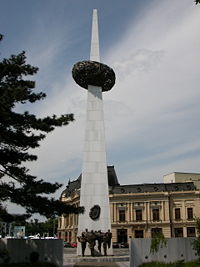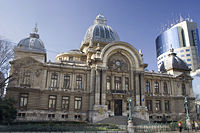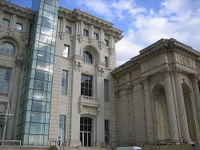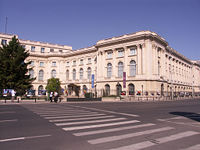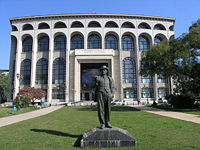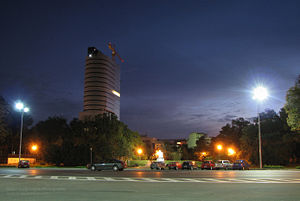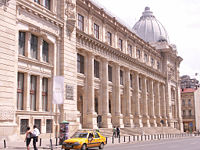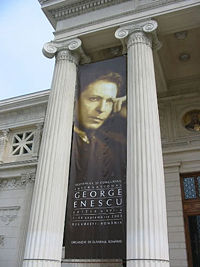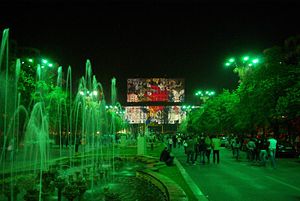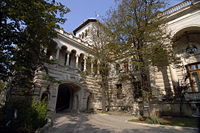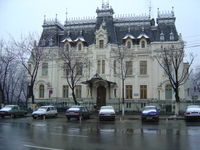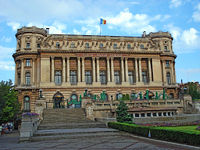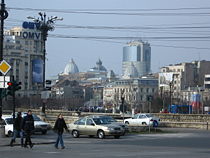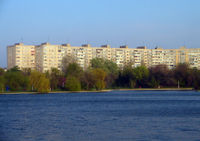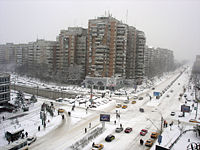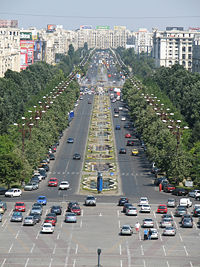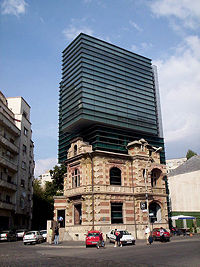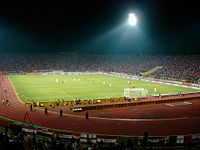Bucharest
2008/9 Schools Wikipedia Selection. Related subjects: Europe; European Cities
| Bucharest Bucureşti |
|||
| The Palace of the Parliament | |||
|
|||
| Nickname(s): Little Paris, Paris of the East | |||
| Motto: Patria si Dreptul Meu (My Country and My Right) | |||
| Location of Bucharest within Romania (in red) | |||
| Coordinates: | |||
|---|---|---|---|
| Country | Romania | ||
| County | Municipality of Bucharest | ||
| Founded | 1459 (first official record) | ||
| Government | |||
| - Mayor | Sorin Oprescu ( Independent) | ||
| Area | |||
| - City | 228 km² (88 sq mi) | ||
| - Metro | 238 km² (91.9 sq mi) | ||
| Elevation | 60 - 90 m (197–295 ft) | ||
| Population (2007-July-11) | |||
| - City | ▲ 1,931,838 | ||
| - Density | 8,510/km² (22,040.8/sq mi) | ||
| - Metro | 2,600,000 | ||
| Time zone | EET ( UTC+2) | ||
| - Summer ( DST) | EEST ( UTC+3) | ||
| Postal Code | 0xxxxx | ||
| Area code(s) | +40 x1 | ||
| Car Plates | B | ||
| Website: www.pmb.ro | |||
Bucharest ( Romanian: Bucureşti /bu.kuˈreʃtʲ/ ) is the capital city, industrial, and commercial centre of Romania. It is Romania's largest city. It is located in the southeast of the country, at , and lies on the banks of the Dâmboviţa River. It was originally known as Dâmboviţa citadel.
By European standards, Bucharest is not an old city, its existence first being referred to by scholars as late as 1459. Since then it has gone through a variety of changes, becoming the state capital of Romania in 1862 and steadily consolidating its position as the centre of the Romanian mass media, culture and arts. Its eclectic architecture is a mix of historical, interbellum, Communist-era and modern. In the period between the two World Wars, the city's elegant architecture and the sophistication of its elite earned Bucharest the nickname of the "Paris of the East" or "Little Paris" (Micul Paris). Although many buildings and districts in the historic centre were damaged or destroyed by war, earthquakes and Nicolae Ceauşescu's program of systematization, many survived. In recent years, the city has been experiencing an economic and cultural boom.
According to January 2006 official estimates, Bucharest proper has a population of 1,930,390. The urban area extends beyond the limits of Bucharest proper and has a population of 2.1 million people. Adding the satellite towns around the urban area, the metropolitan area of Bucharest has a population of 2.6 million people. Bucharest is the 6th largest city in the European Union by population within city limits.
Economically, the city is the most prosperous in Romania and is one of the main industrial centres and transportation hubs of Eastern Europe. As the most developed city in Romania, Bucharest also has a broad range of educational facilities.
The city proper is administratively known as the Municipality of Bucharest (Municipiul Bucureşti), and has the same administrative level as a county, being further subdivided into six sectors.
Etymology
Tradition connects the founding of Bucharest with the name of Bucur who was either a prince, an outlaw, a fisherman or a shepherd according to different legends. The name of Bucur (from "bucurie" meaning "joy") is of Thracian-Geto-Dacian origin. In Albanian, a language which has historical connections with the Thracian languages, "bukur' signifies 'beautiful'.
The official city name in full is The Municipality of Bucharest ( Romanian: Municipiul Bucureşti). Bucharest has been known in Latin as Bucaresta, in Hungarian and German as Bukarest and in French, Italian and Spanish as Bucarest in Dutch as Boekarest.
A native or resident of Bucharest is called Bucharester ( Romanian: Bucureştean).
History
Bucharest's history alternated periods of development and decline from the early settlements of the Antiquity and until its consolidation as capital of Romania late in the 19th century.
First mentioned as "the Citadel of Bucureşti" in 1459, it became a residence of the Wallachian prince Vlad III the Impaler. The Old Princely Court ( Curtea Veche) was built by Mircea Ciobanul, and during following rules, Bucharest was established as the summer residence of the court, competing with Târgovişte for the status of capital after an increase in the importance of southern Muntenia brought about by the demands of the suzerain power, the Ottoman Empire.
Burned down by the Ottomans and briefly discarded by princes at the start of the 17th century, Bucharest was restored and continued to grow in size and prosperity. Its centre was around the street "Uliţa Mare", which starting 1589 was known as Lipscani. Before the 1700s, it became the most important trade centre of Wallachia and became a permanent location for the Wallachian court after 1698 (starting with the reign of Constantin Brâncoveanu).
Partly destroyed by natural disasters and rebuilt several times during the following 200 years, hit by Caragea's plague in 1813-1814, the city was wrested from Ottoman control and occupied at several intervals by the Habsburg Monarchy (1716, 1737, 1789) and Imperial Russia (three times between 1768 and 1806). It was placed under Russian administration between 1828 and the Crimean War, with an interlude during the Bucharest-centered 1848 Wallachian revolution, and an Austrian garrison took possession after the Russian departure (remaining in the city until March 1857). Additionally, on March 23, 1847, a fire consumed about 2,000 buildings of Bucharest, destroying a third of the city. The social divide between rich and poor was described at the time by Ferdinand Lassalle as making the city "a savage hotchpotch".
In 1861, when Wallachia and Moldavia were united to form the Principality of Romania, Bucharest became the new nation's capital; in 1881, it became the political centre of the newly-proclaimed Kingdom of Romania. During the second half of the 19th century, due to its new status, the city's population increased dramatically, and a new period of urban development began. The extravagant architecture and cosmopolitan high culture of this period won Bucharest the nickname of "The Paris of the East" (or "Little Paris", Micul Paris), with Calea Victoriei as its Champs-Élysées or Fifth Avenue.
Between December 6, 1916 and November 1918, it was occupied by German forces, the legitimate capital being moved to Iaşi. After World War I, Bucharest became the capital of Greater Romania. As the capital of an Axis country, Bucharest suffered heavy losses during World War II, due to Allied bombings, and, on August 23, 1944, saw the the royal coup which brought Romania into the anti-German camp, suffering a short but destructive period of Luftwaffe bombings in reprisal. On November 8, 1945, the king's birthday, the Soviet-backed Petru Groza government suppressed pro- monarchist rallies.
During Nicolae Ceauşescu's leadership (1965-1989), most of the historic part of the city was destroyed and replaced with Communist-style buildings, particularly high-rise apartment blocks. The best example of this is the development called Centrul Civic (the Civic Centre), including the Palace of the Parliament, where an entire historic quarter was razed to make way for Ceauşescu's megalomaniac constructions. In 1977, a strong 7.4 on the Richter-scale earthquake claimed 1,500 lives and destroyed many old buildings. Nevertheless, some historic neighbourhoods did survive to this day.
The Romanian Revolution of 1989 began with mass anti-Ceauşescu protests in Timişoara in December 1989 and continued in Bucharest, leading to the overthrow of the Communist regime. Dissatisfied with the post-revolutionary leadership of the National Salvation Front, student leagues and opposition groups organized large-scale protests continued in 1990 (the Golaniad), which were violently stopped by the miners of Valea Jiului (the Mineriad). Several other Mineriads followed, the results of which included a government change.
After the year 2000, due to the advent of Romania's economic boom, the city has modernised and is currently undergoing a period of urban renewal. Various residential and commercial developments are underway, particularly in the northern districts, while Bucharest's historic centre is currently undergoing significant restoration.
| Treaties signed in Bucharest | |||||||||||||
| Treaty of May 28, 1812, at the end of the Russo-Turkish War | |||||||||||||
| Treaty of March 3, 1886, at the end of the Serbo-Bulgarian War | |||||||||||||
| Treaty of August 10, 1913, at the end of the Second Balkan War | |||||||||||||
| Treaty of August 4, 1916, the treaty of alliance between Romania and the Entente | |||||||||||||
| Treaty of May 6, 1918, the treaty between Romania and the Central Powers | |||||||||||||
Geography
General Information
Bucharest is situated on the banks of the Dâmboviţa River, which flows into the Argeş River, a tributary of the Danube. Several lakes – the most important of which are Lake Floreasca, Lake Tei and Lake Colentina – stretch across the city, along the Colentina River, a tributary of the Dâmboviţa. In addition, in the centre of the capital there is a small artificial lake – Lake Cişmigiu – surrounded by the Cişmigiu Gardens. The Cişmigiu Gardens have a rich history, being frequented by famous poets and writers. Opened in 1847 and based on the plans of German architect Carl F.W. Meyer, the gardens are currently the main recreational facility in the city centre.
Besides Cişmigiu, Bucharest contains several other large parks and gardens, including Herăstrău Park and the Botanical Garden. Herăstrău is a large public park located in the north of the city, and the site of the Village Museum, while the Bucharest's botanical garden is the largest in Romania and contains over 10,000 species of plants, many of them exotic; it was once a pleasure park for the royal family.
Bucharest is situated in the south eastern corner of the Romanian Plain, in an area once covered by the Vlăsiei forest, which, after it was cleared, gave way to a fertile flatland. As with many cities, Bucharest is traditionally considered to have seven hills, in the tradition of the seven hills of Rome. Bucharest's seven hills are: Mihai Vodă, Dealul Mitropoliei, Radu Vodă, Cotroceni, Spirei, Văcăreşti and Sf. Gheorghe Nou.
The city has a total area of 226 square kilometres (87 sq mi). The altitude varies from 55.8 metres (183.1 ft) at the Dâmboviţa bridge in Căţelu, south-eastern Bucharest and 91.5 m (300.2 ft) at the Militari church. The city has a relatively round shape, with the centre situated approximately in the cross-way of the main north-south/east-west axes at the University Square. The milestone for Romanian's Kilometre Zero is placed just south of University Square in front of the New St. George Church (Sfântul Gheorghe Nou) at St. George Square (Piaţa Sfântul Gheorghe). Bucharest's radius, from University Square to the city limits in all directions, varies from about 10 to 12 km (6.25–7.5 mi).
Until recently, the regions surrounding Bucharest were largely rural, but after 1989, new suburbs started to be built around Bucharest, in the surrounding Ilfov county. Further urban consolidation is expected to take place when the Bucharest metropolitan area is formed in 2006, which will incorporate various communes and cities of Ilfov and surrounding counties.
Road and rail distances between Bucharest and the other cities
|
|
Road distances between Bucharest and the other european cities
- Athens (1398 km)
- Barcelona (2597 km)
- Beograd (620 km)
- Berlin (1646 km)
- Bruxelles (2136 km)
- Budapest (788 km)
- Chişinau (436 km)
- Kiev (888 km)
- Istanbul (681 km)
- London (2502 km)
- Madrid (3190 km)
- Milano (1642 km)
- Moscow (1758 km)
- Paris (2295 km)
- Sofia (373 km)
- Stockholm (2846 km)
- Wien (1022 km)
- Warsaw (1240 km)
Climate
Bucharest has a continental climate, characterised by hot dry summers and cold winters. Due to its position on the Romanian Plain, the city's winters can get windy, even though some of the winds are mitigated due to urbanisation. Winter temperatures are often below 0 °C (32 °F), even though they rarely drop below −10 °C (14 °F). In summer, the average temperature is approximately 23 °C (73 °F) (the average for July and August), despite the fact that temperatures sometimes reach 35 °C (95 °F) to 40 °C (104 °F) in mid-summer in the city centre. Although average precipitation and humidity during summer is low, there are infrequent yet heavy and often violent storms. During spring and autumn, temperatures vary between 18 °C (64 °F) to 22 °C (72 °F), and precipitation during this time tends to be higher than in summer, with more frequent yet milder periods of rain.
| Weather averages for Bucharest | |||||||||||||
|---|---|---|---|---|---|---|---|---|---|---|---|---|---|
| Month | Jan | Feb | Mar | Apr | May | Jun | Jul | Aug | Sep | Oct | Nov | Dec | Year |
| Average high °C (°F) | 2 (36) | 3 (37) | 10 (50) | 16 (61) | 22 (72) | 26 (79) | 27 (81) | 27 (81) | 23 (73) | 17 (63) | 8 (46) | 3 (37) | 16 (61) |
| Average low °C (°F) | -5 (23) | -3 (27) | 0 (32) | 5 (41) | 10 (50) | 14 (57) | 15 (59) | 15 (59) | 11 (52) | 6 (43) | 0 (32) | -2 (28) | 5 (41) |
| Precipitation mm (inches) | 40 (1.57) | 36 (1.42) | 38 (1.5) | 46 (1.81) | 70 (2.76) | 77 (3.03) | 64 (2.52) | 58 (2.28) | 42 (1.65) | 32 (1.26) | 49 (1.93) | 43 (1.69) | 595 (23.43) |
| Source: weatherbase.com | |||||||||||||
Law and government
Administration
Bucharest has a unique status in Romanian administration, since it is the only municipality that is not part of a county. Its population, however, is larger than that of any Romanian county, and hence the power of the Bucharest General City Hall (Primăria Generală), which is the city's local government body, is about the same as, if not greater than, that of Romanian county councils.
The city government is headed by a General Mayor (Primar General), currently (as of 2008) Sorin Oprescu. Decisions are approved and discussed by the General Council (Consiliu General) made up of 55 elected councillors. Furthermore, the city is divided into six administrative sectors (sectoare), each of which has their own 27-seat sectorial council, town hall and mayor. The powers of local government over a certain area are therefore shared by the Bucharest City Hall and the local sectorial councils with little or no overlapping of authority. The general rule is that the main City Hall is responsible for citywide utilities such as the water system, the transport system and the main boulevards, while sectorial town halls manage the contact between individuals and the local government, secondary streets, parks, schools and cleaning services.
The six sectors are numbered from one to six and are disposed radially so that each one has under its administration an area of the city centre. They are numbered clockwise and are further divided into districts without any form of administration (cartiere):
- Sector 1 with population in 2007 of 228,629 including: Dorobanţi, Băneasa, Aviaţiei, Pipera, Aviatorilor, Primăverii, Romană, Victoriei, Herăstrău Park, Bucureştii Noi, Dămăroaia, Strǎuleşti, Griviţa, 1 Mai, Băneasa Forest, Pajura, Domenii and a small part of Giuleşti - the part with Giuleşti Stadium
- Sector 2 with population in 2007 of 359,107 including: Pantelimon, Colentina, Iancului, Tei, Floreasca, Moşilor, Obor, Vatra Luminoasă, Fundeni, Plumbuita, Ştefan cel Mare, Baicului
- Sector 3 with population in 2007 of 394,812 including: Vitan, Dudeşti, Titan, Centrul Civic, Dristor, Lipscani, Muncii, Unirii
- Sector 4 with population in 2007 of 301,172 including: Berceni, Olteniţei, Giurgiului, Văcăreşti, Timpuri Noi, Tineretului
- Sector 5 with population in 2007 of 287,480 including: Rahova, Ferentari, Cotroceni, 13 Septembrie, Dealul Spirii
- Sector 6 with population in 2007 of 360,638 including: Giuleşti, Crângaşi, Drumul Taberei, Militari, Grozǎveşti (also known as Regie), Ghencea
Like all other local councils in Romania, the Bucharest sectorial councils, the city's General Council and the mayors are elected every four years by the population. Additionally, Bucharest has a prefect, who is appointed by Romania's central government. The prefect is not allowed to be a member of a political party. The prefect's role is to represent the national government at local level, acting as a liaison and facilitating the implementation of National Development Plans and governing programmes at local level. The current prefect of Bucharest (as of 2007) is Călin Deaconescu.
The Municipality of Bucharest, along with the surrounding Ilfov county, forms the Bucharest development region, which is equivalent to NUTS-II regions in the European Union and is used by the European Union and the Romanian Government for statistical analysis and regional development. The Bucharest development region is not, however, an administrative entity.
Justice system
Bucharest's judicial system is similar to that of the Romanian counties. Each of the six sectors has their own local tribunal, while appeals from these tribunals' verdicts, and more serious cases, are directed to the Bucharest Court of Appeals, the city's municipal court. Bucharest is also home to Romania's supreme court, the High Court of Cassation and Justice, as well as other national courts such as the Constitutional Court of Romania and the National Military Tribunal.
Bucharest has its own municipal police force, the Bucharest Police (Poliţia Bucureşti), which is responsible for policing of crime within the whole city, and operates a number of special divisions. The Bucharest Police are headquartered on Ştefan cel Mare Blvd in the city centre, and has a number of precincts throughout the city. From 2004 onwards, each sector City Hall also has under its administration a Community Police force ( Poliţia Comunitară), dealing with local community issues. Bucharest also houses the General Inspectorates of the Gendarmerie and the National Police.
Crime
Bucharest's crime rate is rather low in comparison to other East-European capital cities, with the number of total offences declining by 51% between 2000 and 2004. In particular, levels of violent crime remain very low, with 24 murders and 1069 other violent offences taking place in 2004. Although there have been a number of recent police crackdowns on organised crime gangs, such as the Cămătaru clan, organised crime generally has little impact on public life. Petty crime, however, is more common, particularly in the form of pickpocketing, which occurs mainly on the city's public transport network. Additionally, confidence tricks are sometimes common, especially in regards to tourists, even though the frequency of these tricks has declined in recent years. Levels of crime are higher in the southern districts of the city, particularly in Ferentari, a socially-disadvantaged area mainly inhabited by people of Roma ethnicity.
Although the presence of street children was a problem in Bucharest in the 1990s, their numbers have declined significantly in recent years, currently lying at or below the average of major European capital cities. The same is true for beggars and homeless people, many of them from the Roma minority. However, there are still an estimated 1,000 street children in the city, many of whom engage in petty crime and begging. There has also been speculation that the street children are recruited by professional underground networks for criminal purposes. From 2000 onwards, Bucharest has seen an increase in illegal road races which occur mainly at night in the city's outskirts or on industrial sites.
A significant problem in the city remains institutional corruption, which is seen as the most important justice-and-law related problem in the city.
Demographics
| Historical population of Bucharest | |||||||||||||
| Year | Population | ||||||||||||
|---|---|---|---|---|---|---|---|---|---|---|---|---|---|
| 1789 | 30,030 | ||||||||||||
| 1831 | ▲ 60,587 | ||||||||||||
| 1859 | ▲ 122,000 | ||||||||||||
| 1900 | ▲ 282,000 | ||||||||||||
| 1918 | ▲ 383,000 | ||||||||||||
| 1930 | ▲ 639,000 | ||||||||||||
| January 25, 1948 census | ▲ 1,041,807 | ||||||||||||
| February 21, 1956 census | ▲ 1,177,661 | ||||||||||||
| March 15, 1966 census | ▲ 1,366,684 | ||||||||||||
| January 5, 1977 census | ▲ 1,807,239 | ||||||||||||
| July 1, 1990 estimate | ▲ 2,127,194 | ||||||||||||
| January 7, 1992 census | ▼ 2,067,545 | ||||||||||||
| March 18, 2002 census | ▼ 1,926,334 | ||||||||||||
| July 1, 2005 estimate | ▼ 1,924,959 | ||||||||||||
| January 1, 2006 estimate | ▲ 1,930,390 | ||||||||||||
| July 11, 2007 estimate | ▲ 2,088,500 | ||||||||||||
The city's population, according to the 2002 census, is 1,926,334 inhabitants, or 8.9% of the total population of Romania. Additionally, there are about 50,000 people who commute to the city every day, mainly from the surrounding Ilfov county.
Bucharest's population experienced two phases of rapid growth, the first in the late 19th century, when the city grew in importance and size, and the second during the Communist period, when a massive urbanisation campaign was launched and many people migrated from rural areas to the capital. At this time, due to Ceauşescu's ban on abortion and contraception, natural increase was also significant.
Approximately 97% of the population of Bucharest are ethnic Romanians, with the second largest ethnic group being the Roma, which make up 1.4% of the population. Other significant ethnic groups are Hungarians (0.3%), Jews (0.1%), Turks (0,1%) and Germans (0,1%). Some other inhabitants of Bucharest are of Greek, Armenian, Lipovan and Italian descent. The Greeks and the Armenians used to play significant roles in the life of the city at the end of the 19th century and beginning of the 20th century. One the predominantly Greek neighbourhoods Vitan - where a Jewish population also lived; the latter was more present in Văcăreşti and areas around Unirii Square.
In terms of religion, 96.1% of the population are Romanian Orthodox, 1.2% are Roman Catholic, 0.5% are Muslim and 0.4% are Eastern Rite-Catholic. Despite this, only 24% of the population, of any religion, attend a place of worship once a week or more. The life expectancy of residents of Bucharest in 2003-2005 was 74.14 years, around 2 years higher than the Romanian average. Female life expectancy was 77.41 years, in comparison to 70.57 years for males.
Economy
Bucharest is the most economically-developed and industrialised city in Romania, producing around 21% of the country's GDP and about one-quarter of its industrial production, while only accounting for 9% of the country's population. Almost one third of national taxes is paid by Bucharest's citizens and companies. In 2005, at purchasing power parity, Bucharest had a per-capita GDP of €16,760, or 74.8% that of the European Union average and more than twice the Romanian average. The city's strong economic growth has revitalised infrastructure and led to the development of many shopping malls and modern residential towers and high-rise office buildings. In September 2005, Bucharest had an unemployment rate of 2.6%, significantly lower than the national unemployment rate of 5.7%.
Bucharest's economy is mainly centred on industry and services, with services particularly growing in importance in the last ten years. The city serves as the headquarters of 186,000 firms, including nearly all large Romanian companies. An important source for growth since 2000 has been the city's property and construction boom, which has resulted in a significant growth in the construction sector. Bucharest is also Romania's largest centre for information technology and communications and is home to several software companies operating offshore delivery centers. Bucharest contains Romania's largest stock exchange, the Bucharest Stock Exchange, which was merged in December 2005 with the Bucharest-based electronic stock exchange, Rasdaq.
The city has a number of international supermarket chains such as Carrefour, Cora and METRO. At the moment, the city is undergoing a retail boom, with a large number of supermarkets, and hypermarkets, constructed every year. For more information, see supermarkets in Romania. The biggest modern shopping centres in Bucharest are Bucharest Mall, Plaza Romania, City Mall, Jolie Ville Galleria and Unirea Shopping Centre. However, there are also a large number of traditional markets; the one at Obor covers about a dozen city blocks, and numerous large stores that are not officially part of the market effectively add up to a market district almost twice that size.
In Bucharest the average salary is £1000 a month which is higher than that of Spain. Also as Romania is experiencing a real construction boom the average price for a central one bedroom flat is around £650 which puts the price of rent on par with Paris.
Romania is most importantly feeling the benefits of the new wealth due to the economic boom that it has seen for the recent years.
Transport
Public Transport
Bucharest's extensive public transport system is the largest in Romania and the third largest in Europe. It is made up of the Bucharest Metro, as well as a surface transport system run by RATB (Regia Autonomă de Transport Bucureşti), which consists of buses, trams, trolleybuses and light rail. In addition, there is a private minibus system. The metro and the surface transport system — used to be run by two separate state-owned corporations but have been merged in early 2007 to form the Bucharest Metropolitan Transport Board. As of 2007, there is a limit of 10,000 taxicab licences , down from 25,000 in the 1990s, and the even higher demand is supplied by taxis registered in Ilfov county.
Air
The city is served by two airports: Henri Coandă International Airport (formerly Otopeni) and Aurel Vlaicu International Airport (formerly Băneasa). Henri Coandă is the largest airport in Romania with 5 million passengers in 2007 and the main hub for the national operator TAROM. Delta Air Lines serves Bucharest directly from JFK. It is also connected to several international airports by a wide range of international airlines. The smaller Aurel Vlaicu International Airport is used for charter flights and low-cost carriers.
Railways
Bucharest is the hub of Romania's national railway network, run by Căile Ferate Române. The main railway station is Gara de Nord, or North Station, which provides connections to all major cities in Romania as well as international destinations such as Belgrade, Budapest, Sofia, Vienna, Prague, Moscow, Istanbul, Chisinau, and many others European capital and city. The city also has five other railway stations run by CFR, most important are Basarab (in proximity of North Station), Obor, Baneasa, Progresu, which are in the process of being integrated in a commuter railway serving Bucharest and the surrounding Ilfov county.From the Bucharest depart 7 main line.
Infrastructure
The city's municipal road network is centred around a series of high-capacity boulevards, which generally radiate out from the city centre to the outskirts. The main axes, which run north-south, east-west and northwest-southeast, as well as one internal and one external ring road, support the bulk of the traffic. The city's roads are usually very crowded during rush hours, due to an increase in car ownership in recent years. Every day, there are more than one million vehicles travelling within the city. This has resulted in wear and potholes appearing on many Bucharest roads, particularly secondary roads, this being identified as one of Bucharest's main infrastructural problems. In recent years, there has been a comprehensive effort on behalf of the City Hall to boost road infrastructure and according to the general development plan, nearly 2000 roads are expected to be repaired by 2008.
Roads
Bucharest is also a major intersection of Romania's national road network. It is the origin of most of the country's national roads and motorway, which link the city to all of Romania's major cities as well as to neighbouring countries such as Hungary, Bulgaria and Ukraine. Romania's two motorway currently in operation, the A1 to Pitesti and the A2, in Romanian "Autostrada Soarelui" (the sun motorway) to Dobrogea region and Constanta both start from Bucharest. The planned A3 and A4 freeways will also radiate from the Voluntari region in the city's northern outskirts.
Water
Although it is situated on the banks of a river, Bucharest has never functioned as a port city, with other Romanian cities such as Constanţa and Brăila acting as the country's main ports. However, the Danube-Bucharest Canal, which is 73 km (45 mi) long, is currently in construction and is around 60% completed. When finished, the canal will link Bucharest to the Danube River and, via the Danube-Black Sea Canal, to the Black Sea. This corridor is expected to be a significant component of the city's transport infrastructure and increase sea traffic by a large margin.
Culture
Bucharest has a diverse and growing cultural scene, with cultural life exhibited in a number of various fields, including the visual arts, performing arts and nightlife. Unlike other parts of Romania, such as the Black Sea coast or Transylvania, Bucharest's cultural scene is much more eclectic, without a defined style, and instead incorporates various elements of Romanian and international culture. Bucharest has an eclectic mixture of elements from traditionally Romanian buildings to buildings that are influenced by French architects. It is because of this French influence that Bucharest was once called "the Paris of the East" or "Little Paris."
Landmarks
Bucharest has a number of landmark buildings and monuments. Perhaps the most prominent of these is the Palace of the Parliament, built in the 1980s during the reign of Communist dictator Nicolae Ceauşescu. Currently the largest building in Europe and the second-largest in the world, the Palace houses the Romanian Parliament (the Chamber of Deputies and Senate), as well as the National Museum of Contemporary Art. It is also often used as a convention centre.
Another well-known landmark of Bucharest is Arcul de Triumf (The Triumphal Arch), built in 1935 and modeled after the Arc de Triomphe in Paris. A newer landmark of the city is the Memorial of Rebirth, a stylized marble pillar unveiled in 2005 to commemorate the victims of the Romanian Revolution of 1989, which overthrew Communism. The abstract monument sparked a great deal of controversy when it was unveiled, being dubbed with names such as "the toothpick and the olive", ("măslina-n scobitoare"), as many argued that it does not fit in its surroundings and believed that its choice was based on political reasons.
The Romanian Athaeneum building is considered to be a symbol of Romanian culture and since 2007 is on the list of the Label of European Heritage sights.
Other cultural venues include the National Museum of Art, Museum of Natural History "Grigore Antipa", Museum of the Romanian Peasant (Muzeul Ţăranului Român), National History Museum, and the Military Museum.
Visual arts
In terms of visual arts, the city contains a number of museums featuring both classical and contemporary Romanian art, as well as selected international works. The National Museum of Art of Romania is perhaps the best-known of Bucharest museums. It is located in the former royal palace and features extensive collections of medieval and modern Romanian art, including works by renowned sculptor Constantin Brâncuşi, as well as a prominent international collection assembled by the former Romanian royal family.
Other, smaller museums, contain more specialised collections of works. The Zambaccian Museum, which is situated in the former home of Armenian-Romanian art collector Krikor H. Zambaccian contains works by many well-known Romanian artists as well as international artists such as Paul Cézanne, Eugène Delacroix, Henri Matisse, Camille Pissarro and Pablo Picasso.
The Gheorghe Tattarescu Museum contains portraits of Romanian revolutionaries in exile such as Gheorghe Magheru, Ştefan Golescu, Nicolae Bălcescu and allegorical compositions with revolutionary (Romania's rebirth, 1849) and patriotic (The Principalities' Unification, 1857) themes. The Theodor Pallady Museum is situated in one of the oldest surviving merchant houses in Bucharest and includes many works by Romanian painter Theodor Pallady as well as a number of European and Oriental furniture pieces. The Museum of Art Collections contains the collections of a number of well-known Romanian art aficionados, including Krikor Zambaccian and Theodor Pallady.
Despite the extensive classical art galleries and museums in the city, there is also a contemporary arts scene that has become increasingly prominent in recent times. The National Museum of Contemporary Art (MNAC), situated in a wing of the Palace of the Parliament, was opened in 2004 and contains a widespread collection of Romanian and international contemporary art, in a number of expressive forms. The MNAC also manages the Kalinderu MediaLab, which caters specifically to multimedia and experimental art. There is also a range of smaller, private art galleries throughout the city centre.
Performing arts
Performing arts are one of the strongest cultural elements of Bucharest, and the city has a number of world-renowned facilities and institutions. The most prominent is the neoclassical Romanian Athenaeum, which was founded in 1852, hosts classical music concerts, the George Enescu Festival, and is home to the " George Enescu" Philharmonic. Bucharest is also home to the Romanian National Opera, as well as the I.L. Caragiale National Theatre. Another well-known theatre in Bucharest is the State Jewish Theatre, which has gained increasing prominence in recent years due partly to the fact that it features plays starring world-renowned Romanian-Jewish actress Maia Morgenstern. There is also a large number of smaller theatres throughout the city that cater to specific genres, such as the Comedy Theatre, the Nottara Theatre, the Bulandra Theatre, the Odeon Theatre, and the Constantin Tănase Revue Theatre.
Music and nightlife
Bucharest is home to Romania's largest recording labels, and is often the residence of Romanian musicians. The city's music scene is quite eclectic. Many Romanian rock bands of the 1970s and 1980s, such as Iris and Holograf, continue to be popular, particularly with the middle-aged, while since the 1990s there has been growth in the boy band and hip hop genres. The eclectic pop-rock band Taxi have been gaining international respect, as has Spitalul de Urgenţă's raucous updating of traditional Romanian music. While many discos play manele, a Turkish-influenced type of music that is particularly popular in Bucharest's working class districts, the city has an increasing jazz and blues scene, and, to an extent, eurodance/ trance and heavy metal/ punk. The city's nightlife, particularly its club scene grew significantly in the 1990s, and continues to increase. The city does not have a central nightlife strip, with many entertainment venues dispersed throughout the city centre, with a cluster in the historical centre. One of the city's best known clubs is the Lăptăria Enache and the La Motoare, located above (on the rooftop of) the National Theatre, as well as Fire Club and Club A. Most clubs and bars are located around the centre of the city, from the Piaţa Unirii to Piaţa Romană. Also, a large concentration of rock clubs can be found in the Lipscani area, the old part of the city, in the vicinity of Piata Unirii. Another popular venue, especially among students from the Politehnica University campus, is Club Maxx, located on Splaiul Independentei No. 290.
The city also hosts some of the best electronic/house music clubs in Europe such as Bamboo and Krystal Club. During the summer, Zoom Beach Club is an outdoor club on the shore of a lake and has two separate dance floors. The Office is one of the most exclusive clubs in Bucharest and has a long tradition in clubbing. One of the best cocktail clubs is Deja Vu situated on Balcescu Boulevard Near the Italian church. Other clubs are: Gaia, Fratelli, Glamour, Tipsy, Cotton Club, Pat, Studio Martin and Embryo.
Traditional culture
Bucharest's culture has, especially since the early 1990s, become more modern and worldly in comparison to other Romanian cities. Traditional Romanian culture, however, continues to have an influence in domains such as theatre and music. Additionally, Bucharest has two internationally-renowned ethnographic museums, the Museum of the Romanian Peasant and the open-air Village Museum. The Village Museum, in Herăstrău Park, contains 272 authentic buildings and peasant farms from all over Romania. The Museum of the Romanian Peasant was declared the European Museum of the Year in 1996, and displays a rich collection of textiles (especially costumes), icons, ceramics, and other artifacts of Romanian peasant life.
The Museum of Romanian History is another important museum in Bucharest, containing a collection of artefacts detailing Romanian history and culture from the prehistoric times, Dacian era, medieval times and the modern era.
Cultural events and festivals
There are a number of cultural festivals in Bucharest throughout the year, in various domains, even though most festivals take place in the summer months of June, July and August. The National Opera organises the International Opera Festival every year in May and June, which includes ensembles and orchestras from all over the world. The Romanian Athaeneum Society hosts the George Enescu Classical Music Festival at various locations throughout the city in September every year. Additionally, the Museum of the Romanian Peasant and the Village Museum organise a number of events throughout the year showcasing Romanian folk arts and crafts.
In the 2000s, due to the growing prominence of the Chinese community in Bucharest, several Chinese cultural events have taken place. The first officially-organised Chinese festival was the Chinese New Year's Eve Festival of February 2005 which took place in Nichita Stănescu Park and was organised by the Bucharest City Hall. In 2005, Bucharest was the first city in Southeastern Europe to host the international CowParade, which resulted in dozens of decorated cow sculptures being placed at various points across the city.
Since 2005 Bucharest has its own contemporary art biennale, the Bucharest Biennale. The current (2006) issue (curated by Zsolt Pétranyi) will go on until the end of June, the next edition will be in 2008.
The 2000s also saw an increasing visibility of Bucharest gay culture, with the opening of the Queen's Club, the first LGBT club in the city, in 2001, and the launch of the annual Bucharest GayFest in 2004. The city's first gay pride parade was held as part of the 2005 GayFest.
Architecture
Bucharest's architecture is highly eclectic due to the many influences on the city throughout its history. The city centre is a mixture of medieval, neoclassical and art nouveau buildings, as well as 'neo-Romanian' buildings dating from the beginning of the 20th century and a remarkable collection of modern buildings from the 30s and 40s. Very present as well the mostly-utilitarian Communist-era architecture. The city is lately invaded by contemporary structures such as skyscrapers and office buildings, mainly constructed after 2000.
Historical architecture
Of the city's medieval architecture, most of what survived into modern times was destroyed by the Communists and replaced by high-rise apartment blocks. Still, some historical precincts remain, the most notable of which is the Lipscani area. This precinct contains buildings such as Manuc's Inn and the ruins of the Curtea Veche (the Old Court of the King), and during the Middle Ages was the heart of Bucharest's commercial world. From the 1970s onwards, the area went through urban decline, and many historical buildings fell into disrepair. In 2005, the Lipscani area was entirely pedestrianised and is currently undergoing restoration.
The city centre has also retained architecture from the late 19th century and early 20th century, particularly the interwar period, which is often seen as the "golden age" of Bucharest architecture. During this time, the city grew significantly in size and sought to emulate other large European capitals such as Paris. Much of the architecture of the time belongs to a remarkably strong Modern (rationalist) Architecture current, led by Horia Creanga and Marcel Iancu, which managed to literally change the face of the city. Two notable buildings from this time are the Creţulescu Palace, currently housing cultural institutions including UNESCO's European Centre for Higher Education, and the Cotroceni Palace, the current residence of the Romanian President. Many large-scale constructions such as Gara de Nord, the main railway station, and the National Bank of Romania's headquarters, date from these times. In the 2000s, a wide variety of historic buildings in the city centre underwent restoration. In some residential areas of the city, particularly the high-income northern suburbs, there are many turn-of-the-century villas, most of which were restored after 2000.
Communist architecture
A major part of Bucharest's architecture is made up of buildings constructed during the Communist era replacing the historical architecture with "more efficient" high density apartment blocks - one-fifth of the city was demolished only for constructing the third largest building in the world: Casa Poporului - Palace of the Parliament. In Nicolae Ceauşescu's project of systematization many new buildings were built in previously-historical areas, which were razed and then built upon from scratch. One of the best examples of this type of architecture is Centrul Civic, a development that replaced a major part of Bucharest's historic city centre with giant utilitarian buildings, mainly with marble or travertine façades, inspired by North Korean architecture. Communist-era architecture can also be found in Bucharest's residential districts, mainly in blocuri, which are high-density apartment blocks that house the majority of the city's population.
Since the fall of Communism in 1989, several Communist-era buildings have been refurbished, modernised and used for other purposes. Perhaps the best example of this is the conversion of several agro-alimentary complexes into shopping malls and commercial centres. These giant circular halls, which were most often known as hunger circuses due to the food shortages experienced in the 1980s, were constructed during the Ceauşescu era to act as produce markets and refectories, although most were left unfinished at the time of the Revolution. Modern shopping malls like Bucharest Mall, Plaza Romania and City Mall emerged on pre-existent structures of former hunger circuses. Another example is the modernisation and conversion of a large utilitarian construction in Centrul Civic into a Marriott Hotel. This process was accelerated after 2000, when the city underwent a property boom, and many Communist-era buildings in the city centre became prime real estate due to their location. In recent years, many Communist-era apartment blocks have also been refurbished to improve the city's urban appearance.
Contemporary architecture
The newest contribution to Bucharest's architecture took place after the fall of Communism, and particularly after 2000, when the city went through a period of urban renewal – and architectural revitalization – on the back of Romania's economic boom. Buildings from this time are mostly made out of glass and steel, and often have more than fifteen storeys. Examples include shopping malls (particularly the Bucharest Mall, a conversion and extension of an abandoned building), office buildings, bank headquarters, the Bucharest World Trade Centre and the Chamber of Commerce, which lies on the banks of the Dâmboviţa. As of 2005, there is a significant number of office buildings in construction, particularly in the northern and eastern parts of the city. Additionally, there has been a trend in recent years to add modern wings and façades to historic buildings, the most prominent example of which is the Bucharest Architects' Association Building, which is a modern glass-and-steel construction built inside a historic stone façade. Aside from buildings used for business and institutions, various new residential developments are currently underway, many of which consist of modern high-rise buildings with a glass exterior, surrounded by American-style residential communities. These developments are increasingly prominent in the northern suburbs of the city, which are less densely-populated and are home to middle- and upper-class Bucharesters due to the process of gentrification.
Sports
Football (soccer) is the most widely-followed sport in Bucharest, with the city having various club teams that are known throughout Europe. Four football teams of Bucharest participate in Liga 1 (League 1), formerly Divizia A, the top division in the Romanian football league:
| Club | Founded | Stadium | Notes |
|---|---|---|---|
| FC Sportul Studenţesc | 1916 | Regie Stadium |
|
| FC Rapid | 1923 | Giuleşti Stadium |
|
| Progresul Bucuresti | 1944 | Cotroceni Stadium |
|
| FC Steaua | 1947 | Ghencea Stadium |
|
| FC Dinamo | 1948 | Dinamo Stadium |
|
The Lia Manoliu Stadium is the largest stadium in Romania (capacity: 60,120). Also there are sport centers, like Dinamo Sports Park and the National Sports Centre.
There are also a number of sport clubs for ice hockey, rugby union, basketball, handball, water polo and volleyball. The majority of Romanian track and field athletes, boxers, and a great number of gymnasts are affiliated with clubs in Bucharest. The Athletics and many Gymnastics National Championships are held in Bucharest, one main reason being the city's extensive sporting infrastructure.
Every autumn, Bucharest hosts BCR Open Romania international tennis tournament, which is included in the ATP Tour. Also, the Romanian Davis Cup Team usually plays its matches in Bucharest, either outdoors at the BNR Arena or indoor at the Sala Polivalentă. Ice hockey games are held at the Mihai Flamaropol hall, which holds 8,000 spectators.
For the 2007 season, Bucharest will host a round of the FIA GT Championship at the new Bucharest Ring, on May 20. It is now known as the Bucharest City Challenge
Sister cities
Bucharest has 14 sister cities, including Istanbul, Budapest, London, Moscow, Sofia and the 8 below:
| Country | City | Date |
|---|---|---|
| Montreal | ||
| Beijing | 2005 | |
| Nicosia | 2004 | |
| Athens | 1993 | |
| Amman | 1999 | |
| Chişinău | ||
| Ankara | ||
| Atlanta | 1994 | |
| Damascus |
